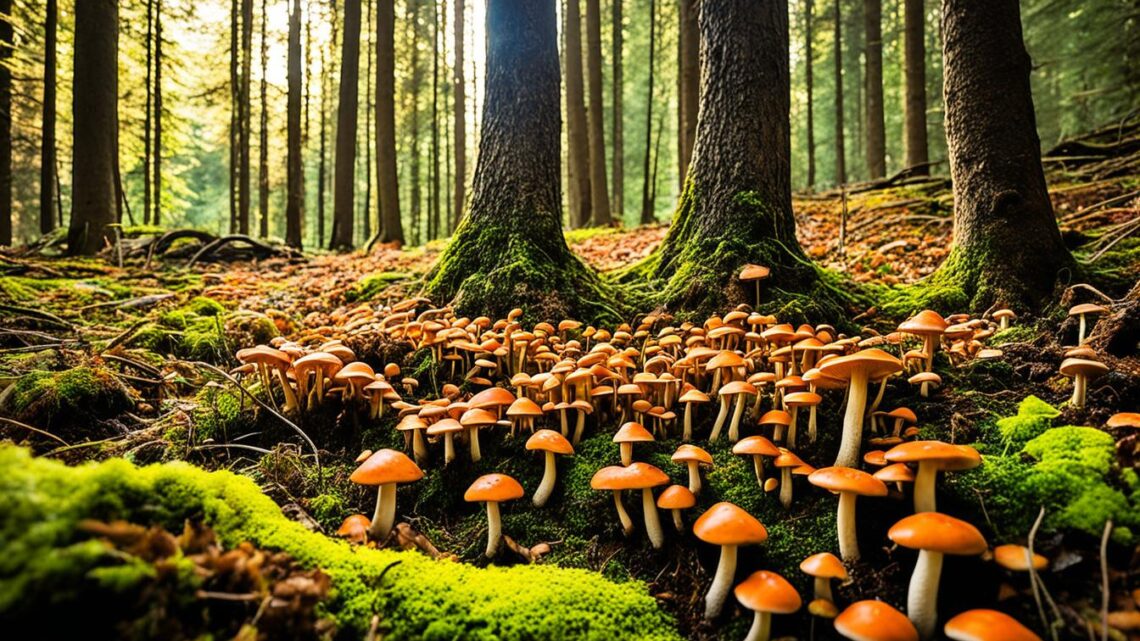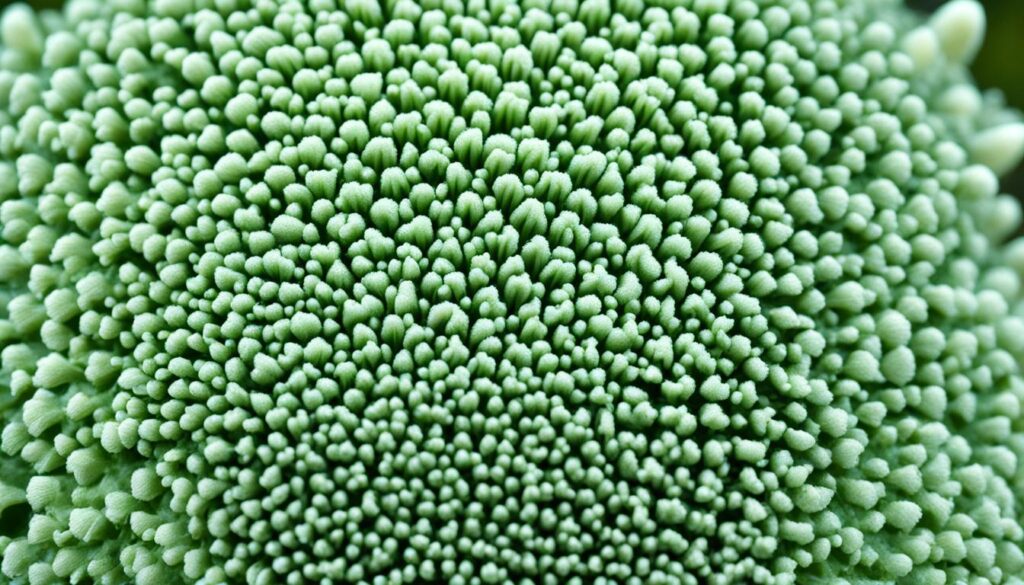
Did you know mushrooms are more like us than plants? They share a deep link with humans. Scientists, chefs, and nature lovers find them fascinating. Mushrooms have strange growth patterns and many types.
They are different from plants in many ways. Let’s explore what makes them special. We’ll look at their health benefits, types, and the network they form.
The Unique Biological Nature of Mushrooms
At first glance, mushrooms might seem like just another type of vegetable. But, they are actually very different from the veggies we usually eat. They belong to the Fungi kingdom, not the Plantae kingdom like vegetables do.
Why Mushrooms Are Not Vegetables
Vegetables are plants that make their own food through photosynthesis. Mushrooms don’t have chlorophyll and can’t make their own food. They break down old stuff to get the nutrients they need. Also, their cell walls are made of chitin, like insect shells, not cellulose like plants.
Mushrooms: A Kingdom of Their Own
Mushrooms are very different from vegetables. They have their own kingdom in the Fungi kingdom, which is full of life with about 12 million species. This shows how special mushrooms are in our world and what they do for us.
| Characteristic | Vegetables | Mushrooms |
|---|---|---|
| Kingdom | Plantae | Fungi |
| Photosynthesis | Yes | No |
| Cell Wall Composition | Cellulose | Chitin |
| Nutrition | Produce own food | Decompose organic matter |

Health Benefits of Mushrooms
Mushrooms are more than just tasty; they’re full of nutrients that boost your health. They are a great source of vitamins, minerals, and antioxidants. These nutrients support your overall health.
Nutritional Powerhouses
Mushrooms are packed with B vitamins like B2, B3, and B5. These vitamins help your body make energy. They also have vitamin D, which is rare in plants and important for bones and immune health.
These fungi are full of minerals like selenium, potassium, and copper. These minerals help protect cells, keep nerves working right, and keep blood vessels healthy.
Boosting Immunity and Fighting Disease
The antioxidants in mushrooms protect your cells from harm. This can lower the risk of chronic diseases and inflammation. Beta-glucans in mushroom walls can make your immune system stronger to fight infections.
Studies show that mushrooms might prevent some cancers, like breast cancer. They do this by fighting estrogen and boosting the immune system.
Adding mushrooms to your meals is an easy way to boost your health. They help your immune system and might lower disease risk. The health perks of mushrooms are amazing.

Mushrooms
Mushrooms come in many shapes, sizes, and flavors. Each type has its own special taste and uses in cooking. From the common button mushrooms to the rich portobello and the savory shiitake, there’s a lot to try.
Common mushrooms like button, cremini, and oyster are great for cooking. You can sauté, grill, or roast them to highlight their flavors. They add depth and richness to many dishes, from stews to sautés.
There are also exotic and wild mushrooms that are rare and sought after. Truffles, morels, and chanterelles are some examples. These mushrooms are known for their strong smell and unique taste. They are often expensive because they are hard to find and highly valued in cooking.
| Mushroom Type | Flavor Profile | Culinary Uses |
|---|---|---|
| Button Mushrooms | Mild, earthy | Sautéing, roasting, grilling, soups, stews |
| Portobello Mushrooms | Rich, savory | Grilling, baking, stuffing, burgers |
| Shiitake Mushrooms | Woodsy, umami-rich | Stir-fries, soups, sauces, risottos |
| Oyster Mushrooms | Delicate, slightly sweet | Sautéing, stir-fries, omelettes, pasta dishes |
| Truffles | Intense, earthy aroma | Shaving over dishes, infusing oils and butters |
| Morels | Nutty, woodsy | Sautéing, scrambling with eggs, risottos |
If you like familiar mushrooms or want to try new ones, there’s a lot to explore in the mushroom world.

Exploring Different Types of Mushrooms
There’s more to mushrooms than just button and portobello. The world of edible fungi is full of flavors, textures, and uses. From the delicate shiitake to the earthy morel, each type adds something special to dishes.
Common Edible Varieties
Button mushrooms, also known as white mushrooms, are loved all over the world. They have a mild taste that fits well in many dishes. Portobello mushrooms are like mature button mushrooms but have a meaty texture perfect for grilling.
Shiitake mushrooms are known for their rich, savory flavor. They are a key ingredient in Asian cooking. Oyster mushrooms are great for stir-fries and soups because they are delicate and mild.
Exotic and Wild Mushrooms
There are also exotic and wild mushrooms that are exciting for food lovers. Truffles are famous for their strong smell and taste. They are a luxury in the kitchen.
Morels have a unique look and a nutty flavor. They are a favorite among mushroom fans.
| Mushroom Variety | Characteristics | Culinary Uses |
|---|---|---|
| Button Mushrooms | Mild, versatile flavor | Widely used in various dishes |
| Portobello Mushrooms | Meaty, grillable texture | Excellent for grilling and roasting |
| Shiitake Mushrooms | Rich, savory taste | Commonly used in Asian cuisines |
| Oyster Mushrooms | Delicate texture, mild flavor | Ideal for stir-fries and soups |
| Truffles | Intense aroma and flavor | Highly prized, luxurious ingredient |
| Morels | Distinctive honeycomb appearance, nutty taste | Sought-after delicacy among mushroom enthusiasts |
If you love mushrooms or are just starting to explore them, there’s a lot to discover. From the well-known button and portobello to the rare truffles and morels, each type has its own special taste and texture.
The Double-Edged Sword: Psychedelic and Dangerous Mushrooms
The mushroom kingdom is full of wonders and dangers. Some mushrooms are great for food and medicine. But, others are known for their strong effects and risks. Psychedelic mushrooms, or «magic mushrooms,» have substances like psilocybin and psilocin. These can change how you see things, make you feel different, and affect your thoughts.
Psychedelic Mushrooms: Nature’s Mind-Altering Wonders
Eating these psychedelic mushrooms can cause vivid dreams, deep feelings, and a new way of thinking. Studies show they might help with depression, PTSD, and addiction. But, they are illegal in many places. So, we must be careful and respectful when dealing with them.
Deadly Fungi: Toxic Mushrooms and Poisoning Risks
Some mushrooms are very toxic and can be deadly, like the Amanita phalloides and the Galerina marginata. Eating them can cause mild stomach issues or even death. It’s important to know which mushrooms are safe before eating them.
Mushrooms are both a blessing and a danger. By learning about their risks and benefits, we can enjoy their wonders safely. This way, we can explore the fascinating world of mushrooms with care and respect.
Overcoming the «Ick» Factor: Why Some People Dislike Mushrooms
Not everyone loves mushrooms, even though they are good for health and cooking. Some don’t like their texture and taste. The slimy or rubbery feel of mushrooms can be off-putting. Others dislike their strong umami flavor, finding it too earthy or savory.
Some people also link mushrooms with decay and decomposition. They grow in damp places and help break down organic matter. This can make some see mushrooms as not clean or wanted, even if they’re safe and healthy to eat.
In some cultural perceptions, mushrooms aren’t common food. This can make people hesitant to try them. Trying new types of mushrooms can be a great experience for those ready to be adventurous.
| Reasons for Disliking Mushrooms | Percentage of People |
|---|---|
| Texture (slimy or rubbery) | 35% |
| Taste (strong umami flavor) | 30% |
| Association with decay and decomposition | 25% |
| Cultural unfamiliarity | 10% |
Understanding why some don’t like mushrooms can help people change their minds. With an open mind and a desire to try new things, the «ick» factor can turn into a love for mushrooms. They offer unique qualities and health benefits.
The Mycelium Network: Nature’s Underground Internet
Underneath the world we see, there’s a complex network of mycelium. These tiny threads, called hyphae, make up a vast underground web. They act like a natural internet, helping fungi talk and share resources.
Understanding the Vital Role of Mycelium
Mycelium is the part of a fungus that grows and takes in nutrients. It can stretch for miles, with a small amount of soil holding up to 200 kilometers of it. The biggest fungus in the world is a honey mushroom network in Oregon, covering over 2,300 acres.
This network is key for breaking down old stuff and giving nutrients back to the soil. It also helps plants by connecting with their roots, making them healthier and stronger.
Mycelium in Popular Culture: «Star Trek: Discovery»
The idea of mycelium has made its way into «Star Trek: Discovery.» The show uses it for a cool «spore drive» that lets spaceships travel fast. This shows how mycelium can inspire new ideas and capture our imaginations.
Mycelium helps with underground communication and is crucial for many ecosystems. Its secrets could lead to big discoveries in science and technology.
| Key Facts About Mycelium | Value |
|---|---|
| Maximum distance mycelium can extend | Hundreds or thousands of miles |
| Mycelial network length in 1 kg of soil | Up to 200 kilometers |
| World’s largest known organism | Honey mushroom network in Oregon (2,300 acres) |
| Percentage of photosynthetic sugar retained by mycorrhizal network | 30% |
The Interconnected World of Mushrooms
Mushrooms and their mycelial networks show us the deep connections in life and nature. They help with nutrient cycling and soil health. They also work with plants in special ways, showing how important fungi are for many ecosystems.
The mycelial network is like an «underground internet.» It shows how life forms communicate and share resources under our feet. This helps plants and other organisms grow strong and survive.
Learning about fungi and mushrooms can make us appreciate life more. Fungi live almost everywhere on earth. Some species can cover huge areas, making them among the biggest living things.
It’s important to value things like plants, clean water, and healthy soil. Mushrooms and their networks are key to keeping our world balanced. They are not just interesting to learn about. They are crucial for our planet.



